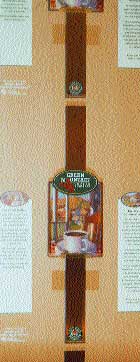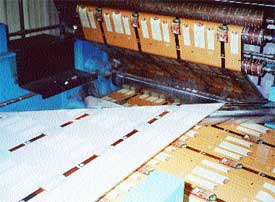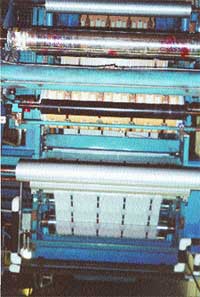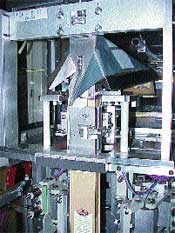Coffee bag web adapts to functional change
|
Product copy runs all the way across the rear label panel of this bag film web on an 11-station gravure press, since the seam will be corner-located when the bag is formed. |
Making an accepted package work better may be a supplier's most important achievement. For what is the packaging field if not a striving toward constant improvement of the most basic product-marketing vehicle?
By this standard, Fres-Co Systems USA's new film web for Green Mountain Coffee's basic bag, and its work in modifying equipment to form and seal the bag has to rank as a masterwork, especially since it needs no drastic restructuring of either materials or machinery.
The adhesive-laminated film, used for other coffee marketers, undergoes three specific processing and forming changes. One is immediately apparent to consumers buying the coffee since March, when the new bag phase-in started; the others, at Green Mountain Coffee's Waterbury, VT, operation, will be noticed by industry people just as quickly.
Certainly no new equipment is involved in producing the web for the squared-off, side-gusseted bag, PD learns during a visit last month to Fres-Co's Telford, PA, headquarters operation. The web, formed using films blown on four lines in the plant, is at the heart of two trademarks Fres-Co holds on its concepts.
Projecting graphics
The first new trademark is called Matte Finish Select™, and it refers to the application of a proprietary scuff-resistant matte coating. This projects Green Mountain's graphics at point of sale in a gloss finish against a near-matte dark green background, printed in a total of seven colors. The MFS coating is the outermost presence on a structure that is reverse-printed 48-ga polyester/adhesive/28-ga aluminum foil/adhesive/48-ga polyester/adhesive/3-mil polyethylene.
The PE, however, isn't the heat-seal agent. Rather, a second proprietary pattern coating is laid down on the PE in-line by Fres-Co and is heat-sealed after filling at Green Mountain Coffee. This relates to Fres-Co's patent for what it dubs the Corner Seal™ package, which does two things.
First, the Corner Seal moves the rear seam to a corner of the bag, virtually concealing the feature and enabling easily readable copy all the way across the rear panel. Second, it facilitates opening of the bag by the consumer without a sharp instrument, but with a simple pull.
|
A proprietary coating is applied after the web is cured and inverted on the mezzanine level of the press, which is only minimally modified for the innovative structure. |
Getting the package to that point, PD discovers, is viewed as almost routine by Fres-Co's Telford staff. "As with all of our materials, we developed and now make the two coatings right here, so we can assure consistency and proper application," says technical director Jeffrey S. Beer.
Not new, but...
Likewise, the equipment to apply the coatings isn't sparkling new. The Green Mountain web runs on a Cerutti Model R940 11-station gravure press during the visit. Installed in '96, the gravure system is the newest of three such presses in Telford.
It is, of course, specially modified for application of the coatings and to laminate the individual layers. One significant change is at the mezzanine level, where the web is roller-inverted to accept the pattern coating right after the curing process.
One addition that keeps the presses running optimally is the incorporation of an Allen-Bradley 5/04 programmable logic the controller, which also facilitates data collection through an interfacing PC downloaded with Wonderware® software. The most recent press was in the process of converting to this software during PD's sojourn. Though less than three months in use, the innovative bag and its crisp configuration and full use of back-panel space is already drawing the attention of packagers other than coffee roasters, PD learns from Fres-Co coffee product manager Chris Burger. "There's no way these developments could be ignored, given the kind of performance and appearance that are now reality and how simple they are to implement," he says, even though these others are outside his bailiwick.
Beer elucidates: "The structure is especially interesting to marketers of products ranging from pet products to dry foods, with eight ounces to one pound being the target range. We expect to see additional commercial products coming to market this year."
He cites the elimination of oxygen permeation through the tight seals formed by the coating as an important advantage, permitting a one-year shelf life with many products. With its bags, which are valved to allow gassing off, Green Mountain Coffee is code-dating for a six-month period.
Burger notes that the two Fres-Co developments are also drawing intense interest among coffee roasters other than Green Mountain. "I think we have a tiger by the tail," he opines, "though it's a very good-looking tiger."
Vertical form/fill/seal machine
To run the new film, Green Mountain installed two new intermittent-motion Fres-Co System USA, Inc. Corner Seal™ Model GL 14 vertical form/fill/seal machines.
Interestingly, the GL machines were not Green Mountain's initial choice. "We went to the PMMI show two years ago to look for new machines to produce the new packages, and we actually had another machine in mind," says Paul Comey, GMC vp of facilities and process engineering. "But after we considered all of the options, the GL machines were an obvious choice. We really like the corner-sealing technology, and we've had a long-term relationship with Fres-Co, which has continued to give us great support."
|
Completed rollstock, printed in seven colors, accumulates at the foot of the press, which dates to '96 and is one of three in the plant. |
The new line of products includes 80 different varieties of ground and whole-bean coffee ranging in weight from 10 to 12 oz. The 332-mil-wide roll of film for the new bags is mounted on the back of the machine and is pulled over dancer rolls to maintain the proper tension. As the film moves up the back, a degassing valve also supplied by Fres-Co is heat-sealed to the inside of the film at the center of the web. The valves are fed from a bowl on the top of the machine onto a track that delivers them to the application point. A slot is machined on the unwind rollers and forming tube to accommodate the valve as the film is pulled through the machine.
After traveling over the top of the machine, the film passes around the square forming collar. Three of the sides are crimped into 5-mil corner seals, while the fourth side is heat-sealed using Fres-Co's Corner Seal™ technology. About 15 mils of extra web are trimmed away after the film is sealed. A label identifying the variety of product in the bag is applied at the forming collar. The four-color, flexo-printed, semi-gloss paper labels, which are printed by Gintzler Graphics, are supplied on a 16-in.-dia roll that contains 2,300 ft of labels on a backing web.
The labeler, which was manufactured by Universal Labeling Systems, Inc. and distributed by Elmark Packaging, applies the labels to the film at the back of the forming collar. The roll of labels is mounted on the side of the machine, and the web is pulled through the machine by a take-up roll, which is mounted next to the feed roll. Labels are stripped from the backing web at the peel plate and transferred onto the blow head, where they are held in place by vacuum. The placement of the label is controlled by the bag machine, which triggers a blast of air that blows the label onto the bag film when the film is in the proper position. After the labels have been stripped from the backing, the web is rewound on the second roll.
The PLC on the labeler, which is in continual communication with the bag machine, signals the machine if there are any problems, such as running out of labels, and stops the bag machine until the fault is corrected.
After the label has been applied, the tube of film travels to the cross-sealing area, where a blast of hot air helps push back the bottom flap, after which jaws come together to complete the cross seal, which seals the top of the lower bag and bottom of the still-connected upper bag.
The next step is bag filling. Product is conveyed to a hopper on top of the machine, which in turn, fills the scales. A sensor in the hopper turns the delivery conveyor on and off to maintain a constant head of product in the hopper to assist in maintaining fill accuracy. Filling is accomplished by two sets of loadcell scales that fill alternate bags. While one scale is filling with product, the other is discharging into a bag. The scales incorporate bulk and dribble filling, in which most of the product is filled rapidly, and the final amount is dribbled in until the proper amount is present. The two sets of scales allow the machine to maintain its 40-bag/min production rate.
After a bag is filled, the top is tack-sealed. Then, the jaws cut it free, and it drops into a bucket on a horizontal indexing conveyor that is an integral part of the machine. To prevent air penetration, nitrogen is maintained in the headspace of the conveyor delivering product to the top of the machine, the scales and the tops of the bags. This nitrogen atmosphere is maintained in the horizontal exit conveyor until the bag is fully sealed.
|
After traveling over the top of the bag machine, the film passes around the square forming collar. |
The exit conveyor carries the bags through the final stages of sealing. Each action occurs while the conveyor is stopped. The first stage is mechanical air evacuation, in which an arm descends and compresses the bag to force out the gas. At the next stage, jaws come in from both sides and seal the bag below the previously applied tack seal. The nitrogen atmosphere is maintained in the horizontal exit conveyor, up to this point. Next, a pendulum-style blade cuts off the tack seal, while leaving 10 to 15 mil of film above the main cross seal that a customer can grasp to pull the two sides of the bag apart.
At the next stage, a tin-tie is applied. This is the bendable plastic strip that is found on many coffee bags (and other types of products) that a user can bend around the top of the bag after it has been folded down. The tin-ties are supplied on a roll by Bedford Industries and the application mechanisms cuts a piece of the proper length and hot-melts it to the bag. This is followed by heater bars that crimp the top of the bag and fold it over to create the cathedral-style top on the bag, after which fingers come in from both sides to fold the tin-tie around the bag. The folding mechanism can also push the top of the bag down flat if that package style is desired, although Green Mountain does not produce any flat-top bags. Finally, the bag drops vertically out of the bucket onto a takeaway conveyor.
The servo-driven machine is equipped with Allen-Bradley controls and an operator screen that sets operating parameters, such as package weights and package lengths for the different products at the touch of a button.
|
The vf/f/s machine incorporates a horizontal exit conveyor on which final sealing and tin-tie placement takes place. |
More information is available:
Web, gas valves, f/f/s machine: Fres-Co Systems USA, 215/721-4600. Circle No. 249.
Press: North American Cerutti Corp., 262/827-8500. Circle No. 250.
Labels: Ginzler Graphics, 716/631-0075. Circle No. 251.
Labeler: Universal Labeling Systems, Inc., 813/327-2123. Circle No. 262.
Labeler Distributor: Elmark Packaging, 610/692-2455. Circle No. 252.
PLC: Allen-Bradley, 414/382-2000. Circle No. 253.
Tin-ties: Bedford Industries, 507/376-4136. Circle No. 365.
About the Author(s)
You May Also Like







